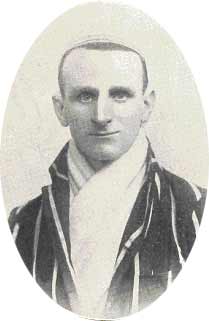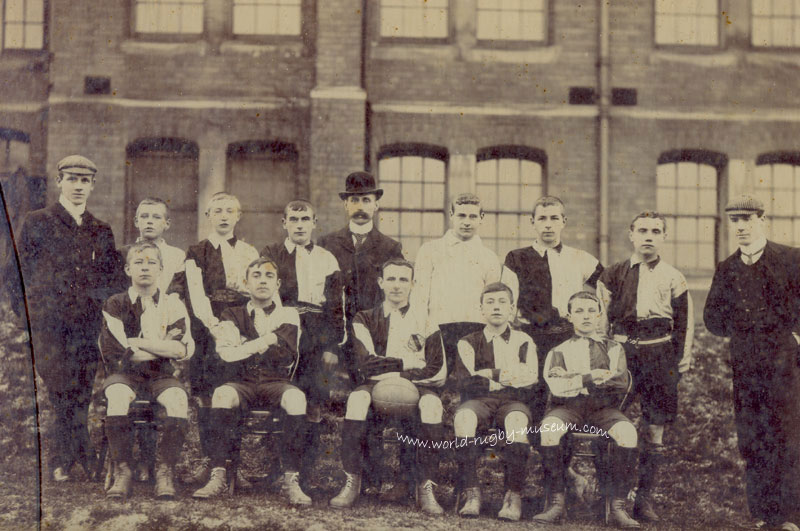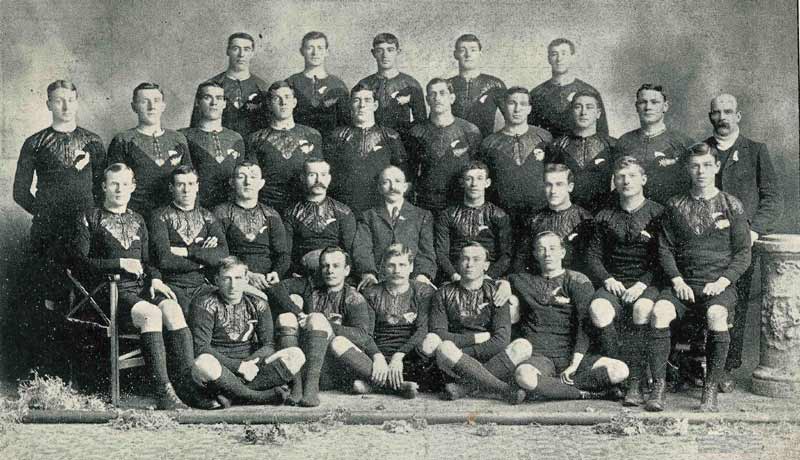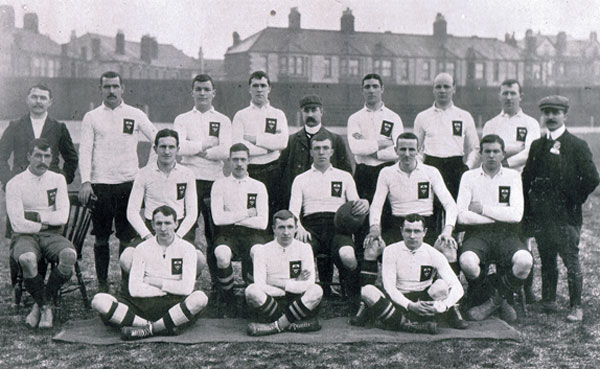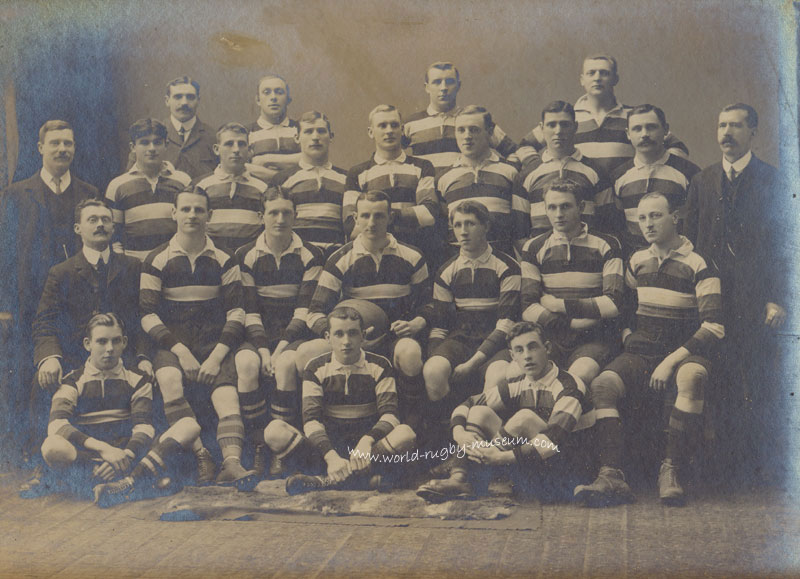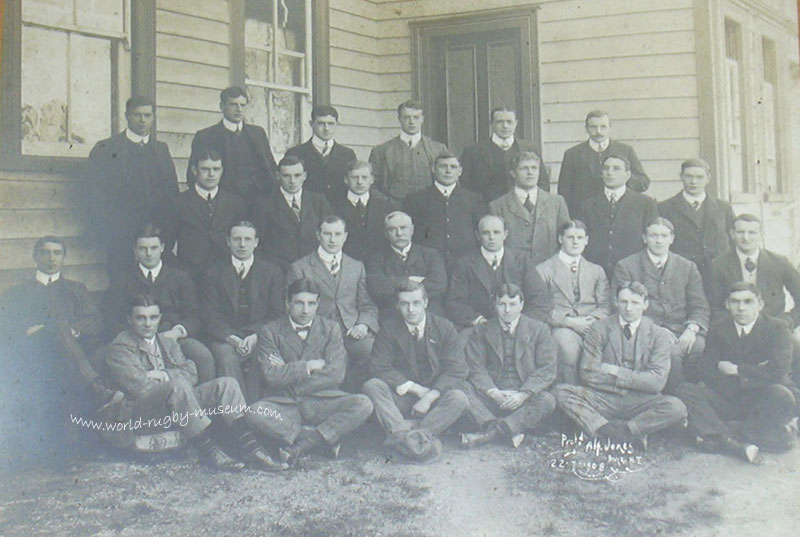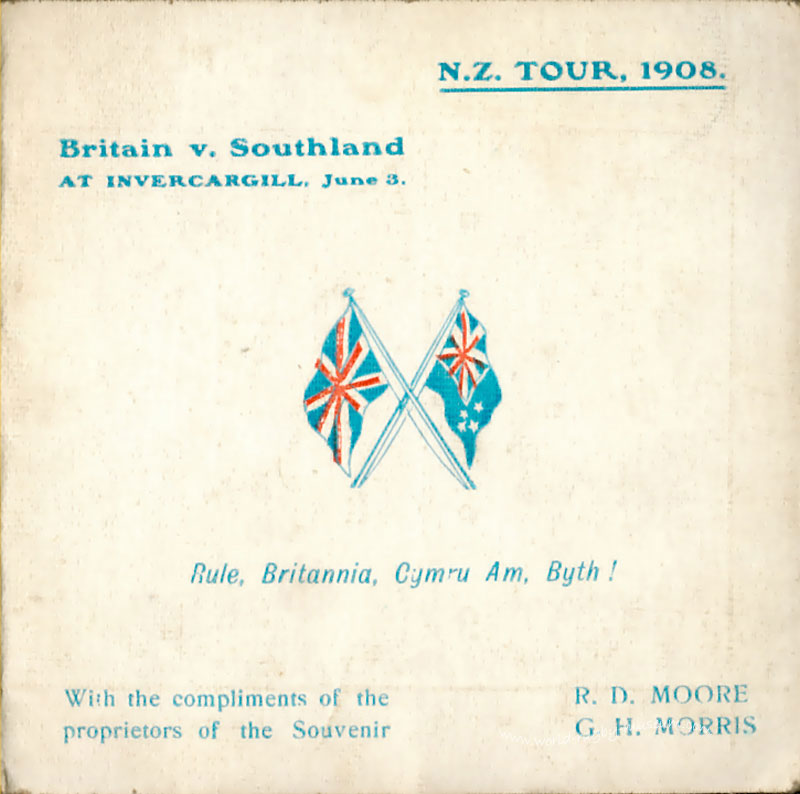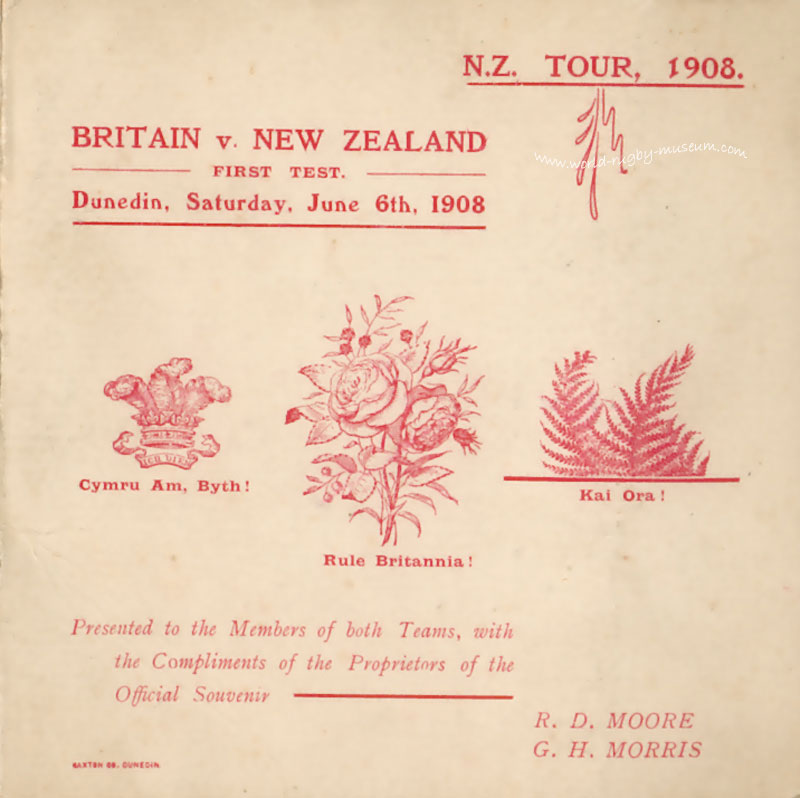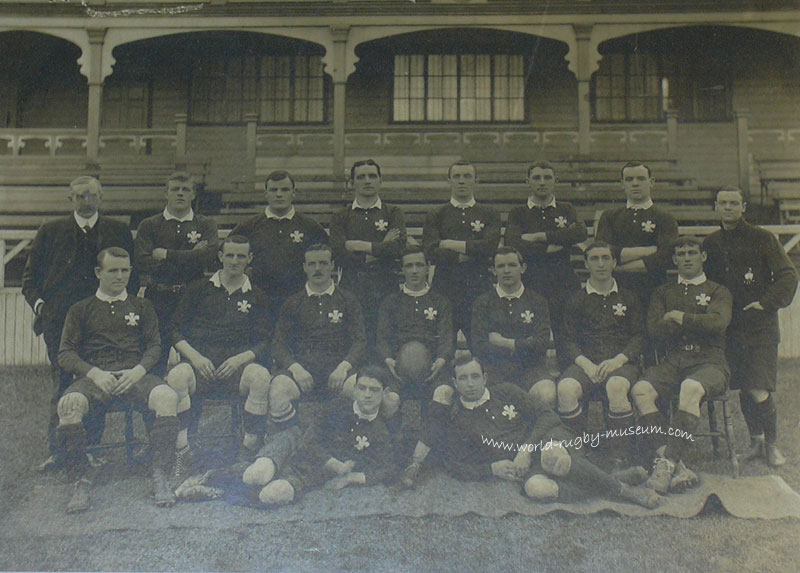| In 1910 he was selected
for the
British Isles
tour of
South Africa
. He had a brilliant tour, captaining
the team in the First Test in the absence of tour captain, Irishman and
fellow
Newport
player Tom Smyth, who was a doctor at
the
Royal
Gwent
Hospital
in
Newport
. The game was played at the Wanderers
Ground,
Johannesburg
, on
6 August 1910
and Jack scored a drop goal in a narrow
14-10 defeat. He played in the victory by 8 points to 3 in the Second
Test at the Crusader Ground,
Port Elizabeth
. The series was all square going into
the Third Test at Newlands in
Cape Town
. In this match, Jack made a try for
half back Jack Spoors, who scored a try in each test, but it was a
consolation score in a disappointing 21-5 defeat. However, Jack’s
defence was exceptional when, with his team down to only 14 men, he
tackled everything that moved. In
total, he made 20 appearances out of a possible 24, scoring tries
against Transvaal Country at
Johannesburg
, North Eastern Districts at Burgersdorp,
Border at
East London
and Border again at King William’s
Town. It was during this British tour that Jack was regarded as ‘The
Prince of Centres’.
|
| |
|
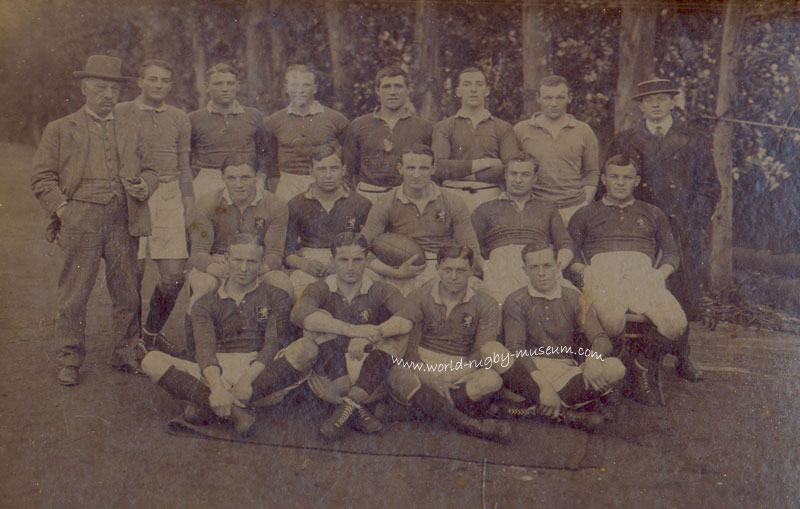
The
British team which played in the First Test
against
South Africa
at the Wanderers
Ground in
Johannesburg
on
6 August 1910
. Jack,
who is holding the ball, was
honoured with the captaincy as tour captain Tom Smyth was
injured. |
|
| |
|
On Jack’s
return, he was approached by
Wigan
and Bradford Northern Rugby League Clubs to
‘go north’ but he rejected their offers. Instead, he re-joined
Pontypool
in December 1910, captaining the club from 1911 to 1913 and going on to
play for
Wales
on another seven occasions. He was a member of
the
Pontypool
team that became Welsh Club Champions for the first time in the 1913-14
season. In his two seasons with
Newport
he scored 9 tries in 45 appearances. Whilst at
Newport
he ‘guested’ for London Welsh at
Bristol
in April 1909.
|
| |
|
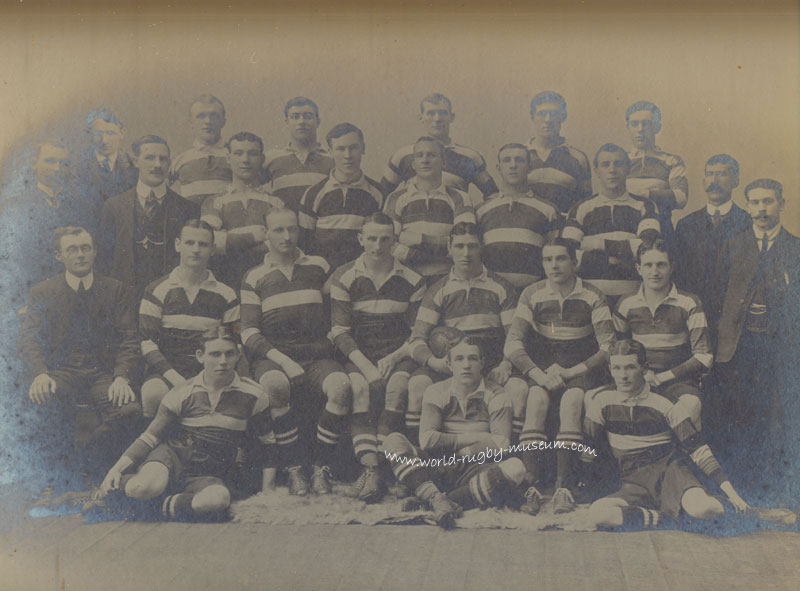
Pontypool
RFC in 1910-11 showing all three Jones brothers.
Cardiff
and
Newport
were defeated at the
Recreation Ground in the early part of the season and wins were
recorded against West Country rivals
Gloucester
,
Bristol
and
Cheltenham
over the Christmas
period. From left to
right, back row: J P ‘Tuan’ Jones, J Jones, T Davies, E
Stephens, H Jarman, A E Hockey.
Second row: E Powell (committee), A Truman (committee), S
Smith, R Harrhy, G Carr, F Andrews, T Carter, W Palmer
(trainer). Third
row: C Greening (secretary), D P ‘Ponty’ Jones, F A
Parkhouse, J P ‘Jack’ Jones, R Thomas (captain), L Bradley,
J H Evans, T Eckley (trainer).
Front row:
S Prosser
, R Lloyd (vice
captain), W J Thomas. |
|
| |
|
He was recalled to
the Welsh team in 1912, playing out of position on the wing against
England
at Twickenham. He was back in the centre versus
France
two months later in the last international
match played at Rodney Parade,
Newport
, scoring a try. He played in the Welsh victory
in
Paris
in 1913 where he was christened ‘The Flying
Dutchman’, and, in March of the same year, was selected as captain of the
Welsh team which defeated
Ireland
scoring his sixth and final try for his
country. This was his last game for
Wales
before the Great War. In March 1913, Jack
became the first player from the
Pontypool
club to play for the famous Barbarians, against
Cardiff
.
|
| |
|
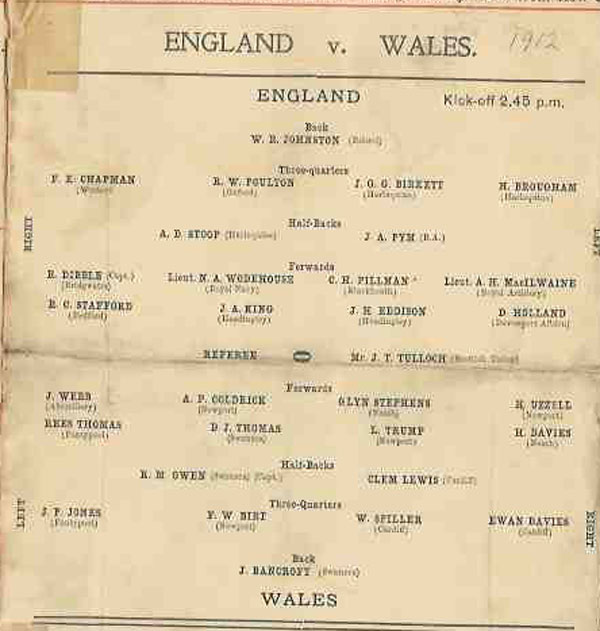
Team line ups from the 1912
England v Wales programme |
|
| |
|
During the First World War,
Jack was assigned to the 3rd Battalion of the 28th (County of London) Battalion,
The London Regiment (Artists’ Rifles), a volunteer battalion formed in the
nineteenth century for musicians, sculptors, painters and the like.
It was a breeding ground for many fine soldiers who were later
commissioned into front-line divisions. Jack, however, was unable to fire a
rifle due to a broken collar bone sustained on the rugby field. He joined up
sometime between
7 December 1917
and
24 January 1918
. He was a Private, with the service number
767452. The 3rd Battalion remained
in
Britain
and formed an Officer’s Training School.
Whether Jack was in this battalion to assist in the training of others or to be
trained himself is unknown.
After the war, Jack played
in the Welsh victories over
France
in
Paris
and
Ireland
in
Cardiff
in 1920. However, he fractured his collar bone
for the third time in his career playing for
Wales
against
England
at Twickenham on
15 January 1921
. It happened about five minutes before
half-time but he played on bravely to the end of the game, despite being in
great pain. This was his last international. Jack was one of only 7 Welsh
players to have been ‘capped’ before and after the Great War. The others
were Clem Lewis (
Cardiff
), Walter Martin (
Newport
), Glyn Stephens (Neath), Harry Uzzell (
Newport
), Tommy Vile (
Newport
) and Jack Wetter (
Newport
).
|
| |
|


Programme & ticket for
Jack's last appearance for Wales |
|
| |
| Jack captained his club (
Pontypool
), county (Monmouthshire), country (
Wales
) and the British team during his
illustrious career. He played his last match for
Pontypool
in the 14 points to 3 defeat of Neath
at the Recreation Ground on
16 April 1921
, towards the end of the club’s
championship-winning season. During the game he broke his collar bone
once again and in August 1921 announced his retirement from rugby at the
age of 35, despite having been elected club captain for the 1921-22
season. He scored 107 tries and a total of 375 points for
Pontypool
. After his retirement from rugby he
took great interest in many sports and in the
village
of
Treharris
, the area from which his mother came. Jack and his brother David
‘Ponty’ worked in the family business as colliery agents with their
yard very near to where they were born at Pontymoile.
|
| |
|

On
25 February 1922
, a dinner was held
in honour of Jack after the home game with
Bristol
, who were great
friends of the
Pontypool
club.
Jack was presented with a cigarette case engraved ‘from
a few rugby friends in
Bristol
’.
Also honoured at the same dinner was a young Cliff
Richards, the
Pontypool
wing, who had
just won the first of his five Welsh caps.

This
appears inside the souvenir brochure. |
|
| |
|
John Phillips
‘Jack’ Jones died of heart failure at his home at Llantarnam (now
Llanfrechfa) on
19 March 1951
aged 65 years.
Jack’s funeral was arranged by Cliff Pritchard, a funeral director from
Capel Street
,
Pontypool
and the former
Pontypool
and
Wales
centre. The funeral took place on
23 March 1951
and the bearers were all former
Pontypool
players – William Vallis, Tom Probert, George Veater and Joe Williams.
Jack was laid to rest in the same grave as his brother, Ponty, at All Saints
Church, Llanfrechfa.
|
| |
|
|
| |
|
JACK JONES - HIS BROTHERS
|
| |
|
Jack had three older
brothers – David Phillips ‘Ponty’ Jones, Edward Phillips Jones (who died
at a young age) and James Phillips ‘Tuan’ Jones.
David ‘Ponty’ and James ‘Tuan’ also went on to play for
Wales
and Tuan for the Anglo-Welsh team. The only
other family to boast three brothers who all played for
Wales
was the Goulds from
Newport
back in the late 19th century.
The eldest of the brothers,
David Phillips Jones, known as Ponty, was born at Pontymoile on
10 December 1881
. He was educated at
Usk
Grammar School
. He played for the old Pontymoile club and
played several games for
Newport
before joining
Pontypool
, making his debut at Ebbw Vale on
7 December 1901
. In his
Pontypool
career, he scored 556 points, including 172
tries. He scored 49 tries in the 1904-05 season, and a then club record 6 in the
game against Talywain in April 1905. This record stood for 98 years and was
broken by Lenny Woodard who scored 7 tries against Treorchy in May 2003. A
classy wing, Ponty scored so many tries at the Recreation Ground that the
nearest left corner looking from
Conway Road
was nicknamed ‘Ponty’s Corner’. He
captained
Pontypool
from 1904 to 1907 and won his only Welsh cap against
Ireland
in 1907, scoring a try. He represented
Monmouthshire, scoring Monmouthshire’s first ever try, and played for London
Welsh. He also played soccer and had
a Welsh amateur soccer trial. A
broken hip eventually ended his rugby career in the 1911-12 season.
He served in the South Wales Borderers during the Great War. A bachelor,
Ponty, who was a professionally trained harpist, died of pneumonia at his home
at Llantarnam (now Llanfrechfa) on
9 January 1936
.
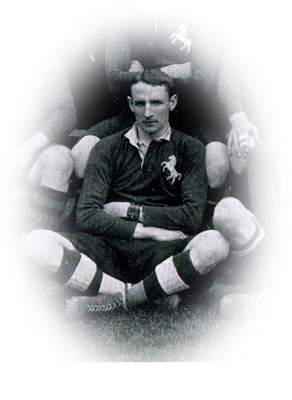
James Phillips Jones
pictured in Kent kit
James
Phillips Jones, known as Tuan, was a doctor of medicine. He was born at
Pontymoile on
23 November 1883
and attended
Christ
College
, Brecon. He joined
Pontypool
in the 1905-06 season. Tuan played for
Kent
against
South Africa
in 1906 whilst a medical student at Guy’s
Hospital and went on to be a General Practitioner in Meopham in
Kent
. A centre or outside half, he joined his
younger brother Jack on the 1908 Anglo-Welsh tour to
New Zealand
and
Australia
, playing in the Second and Third Tests against
the All Blacks. Tuan played for Monmouthshire against the 1912 Springboks and
won his only Welsh cap against
Scotland
in 1913, scoring a try. He also played for
London Welsh. He served in the Royal Army Medical Corps during the Great War and
was awarded the Military Cross for gallantry. Tuan, who was a useful cricketer,
emigrated to
Australia
after the First World War where he married his
wife Pat. The couple had two children, Edward and Elizabeth. He was at the
Victoria
versus British Lions game played at
Melbourne
in 1959 and met up with the two Pontypool Lions
on that tour, Ray Prosser and Malcolm Price.
Dr James Phillips ‘Tuan’ Jones who, as far as can be established, was
the last surviving member of the Anglo-Welsh squad, died at
Melbourne
on
4 December 1964
.
|
| |
|
JACK JONES – THE REST OF
HIS FAMILY
|
| |
|
Jack’s father, Alderman
David Jones, hailed from Rhydlewis near Newcastle Emlyn. He came to
Pontypool
and ran a grocery business at what was known as the Truck Shop in
Pontymoile. This building still exists today in the form of flats. His mother
Margaret (nee Phillips) was born at Pencaedren Farm, Gelligaer near Treharris
and came to
Pontypool
as an apprentice dressmaker. Jack’s mother
and father were married at
Mount Pleasant
Church
,
Pontypool
. The family moved to Trosnant Lodge,
Pontypool
around 1890. Alderman David Jones died in 1919 and his wife in March
1927, just a few months before Jack married Ethel Gwendoline Williams.
Ethel, who was born at
Cwrdy Farm, Griffithstown on
10 April 1891
, met Jack when she went to pay a bill at
Jack’s colliery business. They were married at New Inn Congregational Church
on
3 August 1927
. Jack and Ethel’s daughter Margaret Mary
Gwendoline Phillips Jones was born at Trosnant Lodge,
Pontypool
on
17 June 1929
. In September 1930 Jack, his wife and young
daughter moved to Llantarnam (now Llanfrechfa) to a house they also named
Trosnant Lodge where their son, Stanley John Phillips Jones was born on
16 October 1933
.
Jack’s daughter Margaret
attended the
County
School
,
Pontypool
and then worked in a bank. She married Stuart
Benson in 1956 and moved to
Bristol
then
Weymouth
. They had four children – Susan, Amanda,
Julie and Richard. Stuart’s father was Trevor Benson, a wing or full back who
played rugby for Cross Keys and Monmouthshire in the 1920s, helping the Keys to
the Welsh Club Championship in the 1921-22 season. Margaret, now a widow, still
lives in
Weymouth
.
Son Stan, named after his
mother’s brother who was killed in the First World War, also went to
West
Monmouth
Grammar School
where he played for the school’s cricket and
rugby teams. He was in transport management with British Ports until his
retirement. Stan is single and still lives in the family home at Llanfrechfa.
|
| |
|
JACK
JONES - STATISTICALLY SPEAKING
|
| |
|
Full Name : John Phillips
Jones
Position : Centre
Born:
2 March 1886
at Pontymoile
Died :
19 March 1951
at Llantarnam (now Llanfrechfa)
Playing Career:
West
Monmouth
Grammar School
;
Christ
College
, Brecon;
Pontypool
;
Newport
;
London
Welsh; Barbarians; Monmouthshire;
Wales
; Anglo-Welsh;
British Isles
|
| |
ANGLO-WELSH
- 1908 tour to New Zealand
and Australia
21
appearances, including all 3 tests, scoring a total of 9 tries
-
23
May v Wairarapa-Bush at Recreation Ground, Masterton, won 17-3, scored 1 try
-
27
May v Wellington
at Athletic
Park, Wellington, lost 13-19
-
30
May v Otago at Carisbrook, Dunedin, lost 6-9
-
3
Jun v Southland at Rugby
Park, Invercargill, won 14-8
-
6
Jun v New Zealand
(1st Test) at Carisbrook, Dunedin, lost 5-32
-
13
Jun v Canterbury
at Lancaster
Park, Christchurch, lost 8-13, scored 1 try
-
17
Jun v West Coast-Buller at Victoria Park, Greymouth, won 22-3
-
20
Jun v Nelson-Marlborough at Trafalgar
Park, Nelson, won 12-0, scored 1 try
-
27
Jun v New Zealand
(2nd Test) at Athletic
Park, Wellington, drew 3-3, scored 1 try
-
1
Jul v
Hawkes
Bay
at Recreation Ground, Napier, won
25-3, scored 1 try
-
8
Jul v Manawatu-Horowhenua at Showgrounds Oval, Palmerston North, won 12-3
-
11
Jul v Wanganui at Cook’s Gardens, Wanganui, won 9-6
-
25
Jul v New Zealand
(3rd Test) at Alexandra Park, Auckland, lost 0-29
-
5
Aug v New South Wales
at Sydney Cricket Ground, won 3-0
-
8
Aug v
New South Wales
at Sydney Cricket Ground, won 8-0
-
12
Aug v Western Districts at Wade Park, Orange, lost 10-15
-
15
Aug v Metropolis at Sydney Cricket Ground, won 16-13
-
22
Aug v New South Wales at Sydney Cricket Ground, lost 3-6
-
26
Aug v Queensland
at Brisbane Exhibition Ground, won
20-3, scored 3 tries
-
29
Aug v Queensland
at Brisbane Exhibition Ground, won
11-8
-
2
Sep v Brisbane
at Brisbane Exhibition Ground, won
26-3, scored 1 try
|
| |
BRITISH ISLES
- 1910
tour to South Africa
20
appearances, including all 3 tests, scoring at total of 4 tries and 1 drop goal
-
11
Jun v South Western Districts at Mossel
Bay, won 14-4
-
15
Jun v Western Province Country at Newlands, Cape Town, won 9-3
-
18
Jun v Western Province Colleges at Newlands, Cape Town, won 11-3
-
22
Jun v Western
Province
Town
at Newlands, Cape Town, drew 11-11
-
25
Jun v Western
Province
at Newlands, Cape Town, won 5-3
-
29
Jun v Griqualand West at Kimberley, lost 0-8
-
2
Jul v Transvaal
at Wanderers, Johannesburg, lost 8-27
-
5
Jul v Pretoria
at Pretoria, won 17-0
-
7
Jul v Transvaal Country at Johannesburg, won 45-4, scored 1 try
-
13
Jul v Natal
at Pietermaritzburg, won 19-13
-
16
Jul v Natal
at Lord’s Ground, Durban, won 19-13
-
20
Jul v Orange River Colony at Rambler’s Ground, Bloemfontein, won 12-9
-
23
Jul v Griqualand West at Kimberley, lost 3-9
-
27
Jul v Cape
Colony
at Kimberley, lost 0-19
-
30
Jul v South Rhodesia
at Bulawayo, won 24-11
-
6
Aug v South Africa
(1st Test) at Wanderers, Johannesburg, lost 10-14, scored 1 drop goal and
was captain
-
10
Aug v North Eastern Districts at Burgersdorp, drew 8-8, scored 1 try
-
13
Aug v Border at
East London, won 30-10, scored 1 try
-
17
Aug v Border at King William’s Town, drew 13-13, scored 1 try
-
27
Aug v South Africa
(2nd Test) at Crusaders, Port Elizabeth, won 8-3
-
3
Sep v South Africa
(3rd Test) at Newlands, Cape Town, lost 5-21
|
| |
|
WALES
14
appearances scoring 6 tries, the first 7 caps from Newport
and the final 7 as a Pontypool
player
-
12 Dec 1908
v Australia
at Cardiff
Arms
Park, won 9-6
-
16 Jan 1909
v England
at Cardiff
Arms
Park, won 8-0
-
6 Feb 1909
v Scotland
at Inverleith, won 5-3
-
23 Feb 1909
v France
at Stade Colombes, Paris, won 47-5,
scored 2 tries
-
13 Mar 1909
v Ireland
at St Helen’s, won 18-5, scored 1
try
-
1 Jan 1910
v France
at St Helen’s, won 49-14, scored
1 try
-
15 Jan 1910
v England
at Twickenham, lost 6-11 (Wales' first match at Twickenham)
-
20 Jan 1912
v England
at Twickenham, lost 0-8 (played on
the wing)
-
25 Mar 1912
v France
at Rodney Parade, Newport, won 14-8, scored 1 try
-
27 Feb 1913
v France
at Parc des Princes, Paris, won 11-8
-
8 Mar 1913
v Ireland
at St Helen’s, won 16-13, scored
1 try and was captain
-
17 Feb 1920
v France
at Stade Colombes, Paris, won 6-5
-
13 Mar 1920
v Ireland
at Cardiff
Arms
Park, won 28-4
-
15 Jan 1921
v England
at Twickenham, lost 3-18
|
| |
|
MONMOUTHSHIRE
12
appearances, from
Pontypool
, scoring 3 tries, 1 conversion and
1 drop goal
-
25 Mar 1905
v Cumberland
at Pontypool, won 17-8, scored 2 tries
-
16 Oct 1905
v Glamorgan at Pontypool, lost 6-8
-
19 Feb 1906
v Yorkshire
at Pontypool, won 13-5, scored 1 try
-
1 Mar 1906
v Glamorgan at Cardiff, lost 4-11, scored 1 drop
-
22 Nov 1906
v Glamorgan at
Cardiff, lost 3-24
-
26 Dec 1906
v South Africa
at Newport, lost 0-17
-
13 Feb 1907
v South of Ireland at Abertillery,
won 23-3
-
25 Feb 1907
v Yorkshire
at Tredegar, won 12-3, was captain
-
28 Sep 1907
v Yorkshire
at Ilkley, won 13-8
-
17 Oct 1907
v Somerset
at Bath, won 17-3, scored 1 conversion
-
26 Mar 1908
v Stade Francais at Paris, won 13-6
-
9 Feb 1911
v Somerset
at Newport, won 16-3
|
| |
BARBARIANS
1
appearance
|
| |
|
PONTYPOOL
Debut
29 November 1902
v Machen (a) won 9-3. Last
match
16 April 1921
v Neath (h) won 14-3
Scored
107 tries, 2 conversions, 2 penalties and 11 drops = 375 points
-
1902-03
did not score
-
1903-04
1 try = 3 points
-
1904-05
19 tries, 1 conversion and 2 drops = 67 points
-
1905-06
15 tries, 1 conversion and 5 drops = 67 points
-
1906-07
14 tries, 1 penalty and 1 drop = 49 points
-
1907-08
5 tries = 15 points – club captain
-
1910-11
7 tries, 1 penalty and 1 drop = 28 points
-
1911-12
19 tries and 1 drop = 61 points – club captain
-
1912-13
5 tries = 15 points – club captain
-
1913-14
16 tries and 1 drop = 52 points
-
1919-20
3 tries = 9 points
-
1920-21
3 tries = 9 points
|
| |
NEWPORT
Debut
21 Nov 1908
v Gloucester
(a) won 8-3:
Last
match
29 March 1910
v
Plymouth
(h) won 22 -0, scored 1 try
45
appearances scoring 9 tries = 27 points
|
| |
|
LONDON
WELSH
|
| |
|
CHRIST
COLLEGE,
BRECON
|
| |
|
This page has
looked back at the brilliant career of a rugby legend in the hope that his
achievements can be acknowledged and appreciated.
I would
like to express my sincere thanks to Jack’s son Stan for allowing me the
opportunity to produce this work, for his kind assistance in recalling his
father’s career and for access to Jack’s wonderful archive of memorabilia.
My grateful thanks to rugby historians and memorabilia enthusiasts Dave
Fox and Mark Hoskins for their advice and guidance, to local history
enthusiast Bryan Roden for the use of some photographs and to the World Rugby
Museum for publishing this webpage.
Ray Ruddick,
Griffithstown,
Pontypool, February 2004
All
text and photographs on this page are Copyright
© Ray Ruddick &
World Rugby Museum, and may not be re-produced without permission
|
